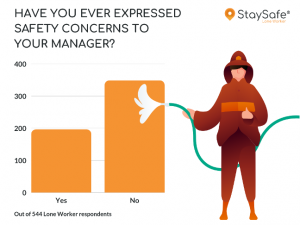UK has 5 Million Hidden Lone Workers
New research shows that 64% of UK employees who regularly work without close contact or supervision would not consider themselves a lone worker, therefore putting their safety at significant risk.
StaySafeApp.com, a smartphone app and cloud-based monitoring service which monitors the location of 60,000 employees via GPS or satellite whilst they are at work and alerts their employer if they do not check-in within a specified time, commissioned the survey of 1,500 lone workers and health and safety professionals.
Nine out of ten survey respondents stated they are working away from colleagues for three or more days per week, and yet, more than half of those don’t see themselves as a ‘lone worker’.
Vulnerable workers

The majority of companies who responded to the survey (68%) have experienced an incident involving a lone worker in the past three years, with a fifth of these incidents described as severe or very severe. In addition, nearly a quarter of staff feel unsafe at least once a year.
Lone workers may also be at an increased risk of stress and fatigue. More than half of incidents involving lone workers (59%) involve stress, mental health issues and tiredness. This indicates that lone workers may have a tendency to feel under increased pressure at work, work long hours or lack support from colleagues.
Accidents, ill health, aggression and violence made up the remaining 41% of recorded lone worker incidents. Manual, traditionally male-dominated industries have higher rates of incidents overall, with utilities, telco, engineering and construction experiencing the highest level, closely followed by transport and distribution.
 Lack of training
Lack of training
Only half (51%) of lone workers stated they know a company has ultimate responsibility for their safety and two thirds (66%) claim that they have not had any formal training or briefings on lone worker safety regulations. A significant number of lone workers are left vulnerable, as only half of employees who are concerned about violence and aggression associated with their role, claim to have had conflict resolution training.
Interestingly, industries which carried out the most training also recorded the lowest numbers of lone worker incidents, which indicates there is a positive correlation between training and increased levels of safety.
Larger companies are more likely to undertake health and safety training for their lone workers, with companies employing more than 1000 people 23% more likely to hold training sessions than those with less than 250 staff members.
Training is most common within charities, social services and the NHS, whilst companies operating within the utilities, teleco, engineering and construction space were found to be the least likely to have undertaken formal safety training for their lone workers.
Don Cameron, CEO of StaySafeApp.com, comments: “Our report has highlighted the disconnect between employee perception and the reality of their lone worker status. It is, as the saying goes, quite literally an accident waiting to happen. It’s estimated that there are up to 8 million lone workers in the United Kingdom, which is 22% of the 31.2 million UK working population. The NHS alone is estimated to employ 100,000 staff who work alone every day.”
 What is the definition of a lone worker?
What is the definition of a lone worker?
Lone working has grown in popularity as advances in technology make it possible for staff to work remotely with ease and carry out complex tasks alone. This means you are likely to find lone workers in almost every industry today, from local authorities to construction, healthcare to engineering and charities to utilities.
Lone workers face similar types of risks to non-lone working employees. However, as any risks are faced alone, they are more vulnerable to harm. Lone working is considered a higher risk activity for a variety of reasons. For example, lone workers may be more susceptible to attack because they are seen as an easy target. If they suffer an accident or other emergency situation, there is no one with them to help or call for assistance. A lone employee may take on more physical work, such as lifting, than they are capable of because no one is there to help and then hurt themselves as a result.
The importance of response times in an emergency
Accidents and injuries can happen at work, no matter how stringently you adhere to legislation and guidance.
However, one thing that can have a positive impact in the event of an emergency is reducing response times – especially for those who work alone.

One way to reduce the response time for your staff in an emergency is to use a specialist lone worker solution.
The StaySafe app gives organisations visibility of the location and safety status of lone working staff, and allows them to check-in safely once they have finished a period of lone working or travelling – or signal for help at any time.
As well as missed welfare check and panic alerts, StaySafe’s Fall Detection feature utilises the phones’ in-built accelerometer technology to raise an automatic alert if an employee suffers a fall.
The cloud-based monitoring hub can be monitored in-house, or outsourced to a 24/7 professional monitoring service (ARC), who will monitor and respond to alerts on your behalf.
ARC’s are also able to issue a Unique Response Number (URN) which requests a direct response from the emergency services, bypassing the 999 service.
Are you responsible for lone worker safety in your organisation? Here’s five facts every employer should know about lone working


 Lack of training
Lack of training What is the definition of a lone worker?
What is the definition of a lone worker?





